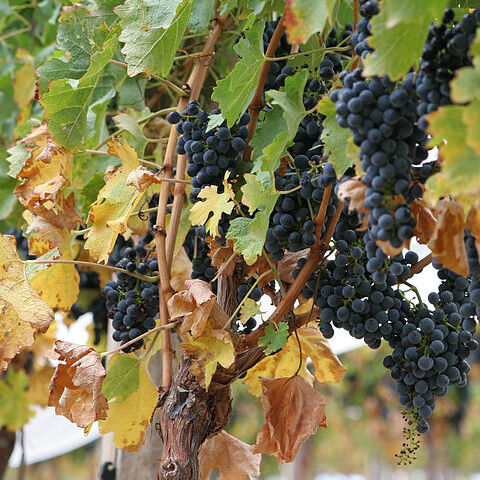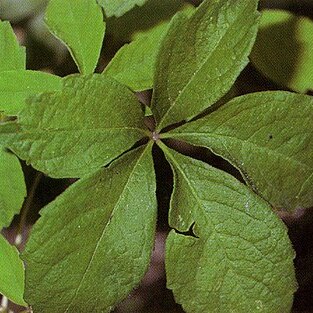Vines or lianas, occasionally shrubby [trees], synoecious, dioecious, or polygamomonoecious; commonly with multicellular, stalked, caducous, spheric structures (pearl glands); tendrils usually present, rarely absent. Leaves alternate, simple or palmately or pinnately compound; stipules present; petiole present; blade often palmately lobed, margins dentate, serrate, or crenate; venation palmate or pinnate. Inflorescences bisexual or functionally unisexual, axillary or terminal and appearing leaf-opposed, cymes or thryses [spikes]. Flowers bisexual or unisexual; perianth and androecium hypogynous; hypanthium absent; sepals 4–5(–9), connate most or all of length; petals (3–)4–5(–9), distinct (connate distally, forming calyptra, in Vitis) [connate basally], valvate, free; nectary intrastaminal; stamens (3–)4–5(–9), opposite petals, distinct; anthers dehiscing by longitudinal slits; staminodes present in functionally pistillate flowers; pistil 1, 2[–3]-carpellate, ovary superior, 2[–3]-locular, placentation axile, sometimes appearing parietal; ovules 2 per locule, apotropous or anatropous; style 1; stigma 1 [4]. Fruits berries. Seeds 1–4 per fruit.
Woody or herbaceous monoecious, polygamodioecious or polygamomonoecious climbers usually with leaf-opposed tendrils, rarely absent, rarely herbs, shrubs or small trees, evergreen or deciduous. Leaves alternate, rarely lower leaves opposite, simple, lobed, or digitately, pedately or 1–4-pinnately compound, entire, crenate, dentate or serrate, petiolate; stipules present and often caducous or rarely absent (not in Australia). Inflorescences panicles, corymbs or rarely spikes, bisexual or functionally unisexual, leaf-opposed, axillary or terminal. Flowers bisexual or unisexual, actinomorphic. Sepals 4–5 (–9), connate. Petals (3) 4 or 5 (–9), free or fused at base or apex, valvate in bud, persistent or caducous. Floral disc present. Stamens 4 or 5 (–7), free, opposite petals; anthers dehiscing by longitudinal slits, bi-or tetra-sporangiate; staminodes present in female flowers. Ovary superior, 2 (–5)-carpellate, 2–6 (–10)-locular; placentation axile, sometimes appearing parietal; ovules 1 (Leea) or 2 per locule; stigma 1 or rarely 4 (Tetrastigma). Fruit a berry. Seeds 1–4 per fruit, with endosperm.
Predominantly climbing herbs or lianes, but sometimes erect or trailing herbs, shrubs or small trees, occasionally distinctly succulent; tendrils often present, leaf-opposed or arising from the peduncle. Leaves alternate, simple or digitately compound, rarely pedate, entire or toothed, stipulate. Flowers regular, usually hermaphrodite, mostly in much-branched cymes. Calyx entire or 4–6-lobed. Petals 4–6, free or cohering at apex, valvate. Stamens 4–6, opposite the petals; filaments free; anthers 2-thecous, medifixed with longitudinal dehiscence. Disk intrastaminal, annular or of separate glands. Ovary superior, 2-locular, each locule with 2 erect ovules; style short or slender; stigma subulate to capitate. Fruit a 1–4-seeded berry. Seeds ovoid, often pointed at one end; endosperm copious, sometimes ruminate
Leaves alternate, simple or digitately compound or rarely pedate, margin variously toothed or rarely entire; stipules petiolar; tendrils present or absent, leaf-opposed or arising from the peduncle
Stamens 4–6, opposite the petals; filaments free; anthers 2-locular, medifixed with longitudinal dehiscence
Ovary superior, 2-locular; ovules 2 in each loculus; style short; stigma subulate to capitate
Erect trailing or climbing perennial herbs, climbing shrubs or rarely small trees
Disk intrastaminal, annular or of separate glands
Seeds with copious sometimes ruminate endosperm
Flowers actinomorphic, usually bisexual
Fruit baccate, with 1–4 seeds
Calyx subentire or 4–6-lobed
Petals 4–6, free, valvate


